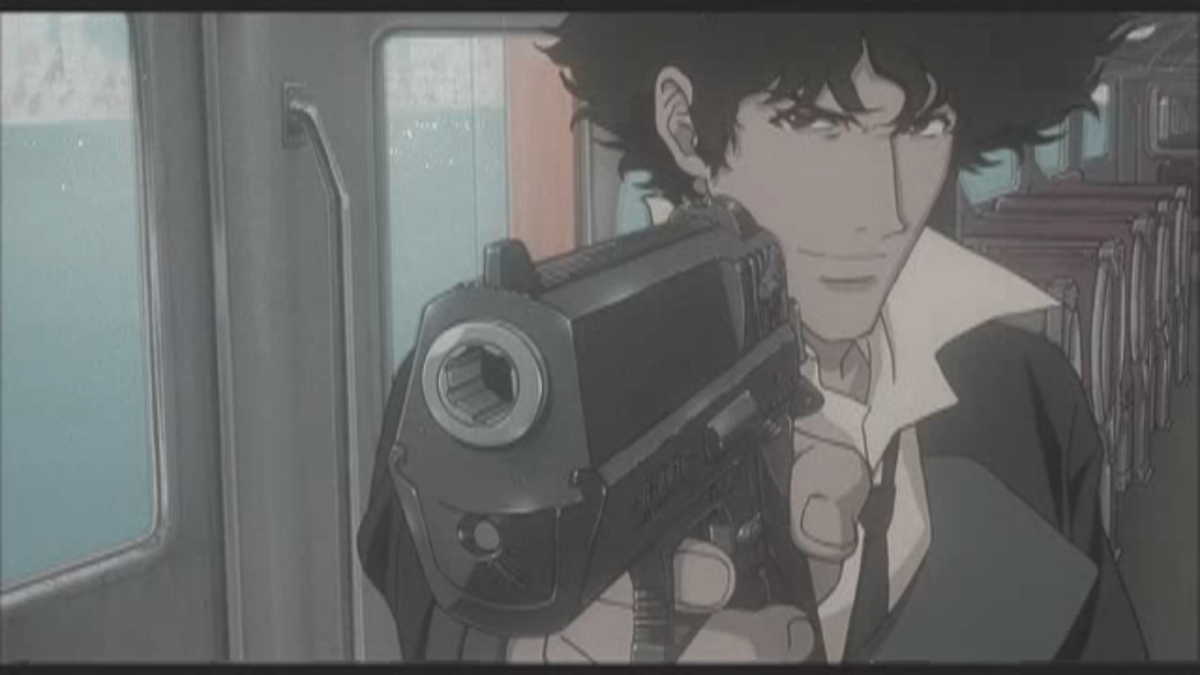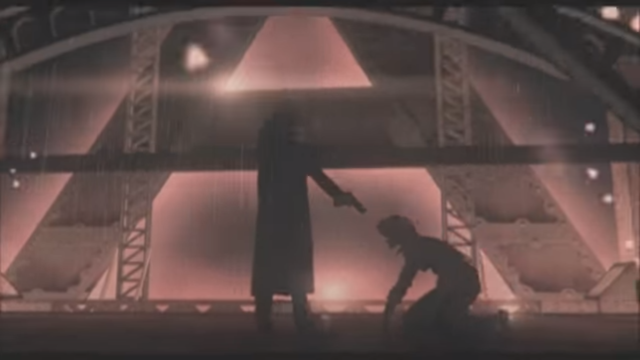“We don’t protect or serve, this is strictly business.”
And yet the Cowboy Bebop crew get to play the heroes in the 2001 stand-alone film Cowboy Bebop: The Movie. Directed by Shinichiō Watanabe, based off of Hajime Yatate’s original series, Watanabe created a film that doesn’t alienate original fans, but that newcomers could enjoy as well. Sure, this means new opening credits and abbreviated backstories, but the characters are all the same and, most crucially, the tone hasn’t changed at all. There is still a roguish air to the story, and the atmosphere often trumps the script, which is fine considering it’s so lush and intriguing.
What does work monumentally in the film’s favor is that it gets to flesh out its villain, rather than trying to cram in a motive, characterization and backstory into under 30 minutes. The villain of the film is Vincent Volaju, who had been believed to be killed in the Titan War. Instead, he was the lone survivor of a test involving a pathogen that he plans to release onto the entire city, as he was immunized with a test vaccine. Due to these tests he suffers from hallucinations and his inability to tells dreams from reality has driven him insane. He’s disconnected from reality, and only has one real human connection in the form of Elektra, another new character for the movie who aids Spike and co. in capturing Vincent. His plan involved releasing the pathogen in jack-o-lantern balloons, as city patrons would all be corralling in the streets to watch the Halloween parade. The Bebop crew must race against time in order to stop Vincent, and find a way in releasing the cure to the citizens below which involves some weather doctoring.
For the bite sized, cinematic treasures that we know the Cowboy Bebop universe to be, the film, running at two hours, is much more content than we’re used to. Still, it gives time to flesh out the narrative, and raise the stakes so that by the ending scene, the fight between Spike and Vincent lands hard. Sure, it seemed at first that the film ended a little abruptly, but it just shows that the series is still comfortable ending an installment when there is simply no more story to tell.
So, as you can tell, I definitely enjoyed the film, but there were parts that were eye roll inducing, and parts that didn’t quite sit as well with me as I’d hoped.
The Weird/Bad
- The treatment of Faye was far from awesome. Like, really, really, annoying and sexually exploitative…again. Faye is such a great character that the films utilization of her seemed wasteful. She’s captured by Vincent, who forcefully kisses her as she’s passing out from the released pathogen. Later, while she’s laying on the ground, he cuts open her shirt, with no real purpose other than for the director to get a shot at her breasts. Her character/outfit has always been one of the more cringe worthy aspects of the show, but in the movie it was even worse.
- Where on earth were Ed and Jet? The film started out so great with Jet telling Spike that he’s all impulse and instinct after a small bounty put a woman’s life in risk. These distinctions between the two characters have always made their partnership intriguing, and you’d think the film could have managed to have Jet do more than simply gather information. It’s better than Ed however, who seems to have nothing to do.
The Good
- Spike Focus. Despite my annoyance at how the other original characters were handled, I was glad to see Spike get so much focus in the film, where it seems we learn more about him than we have in the 17 episodes leading up to my watching it. His scene in the cell with Elektra is particularly strong, and while he’s always worked as a mysterious figure in the series, it’s nice to see him get more depth. He starts the film by willingly putting other lives in danger just to catch one bounty, and ends it by trying to save an entire city, even if it means putting himself in danger.
- Stunning animation. The animation in the movie is ridiculous, so much so, that I’m wondering if it’s going to be jarring to go back to the series which had a rougher around the edges tone. The film had a bigger budget and it shows, with fluid action scenes, sweeping shots, and characters that are given sleeker, smoother looks. The ending fight scene between Vincent and Spike has a grand scale to it, surrounded by towering beams as the skyline bleeds behind them, turning them into shadowy silhouettes. It’s a beautifully constructed film.
- The train fight sequence and ending fight scene are cinematic and exciting. The one on the train between Spike and Vincent is particularly brutal. The one at the end on the clock tower is agile in the way it’s shot, with Spike and Vincent being worthy partners, and it’s shot with a quick, action film intensity, that makes you focus to keep up. If the only good parts of the film had been the action scenes and the animation, it almost would have been enough to tide fans over.
I think I might have ended up screwing with the appropriate placement of seeing the Cowboy Bebop movie, but it was totally worth it and a perfect watch for a gloomy Sunday night watch last weekend as myself and roommates were coming off of Halloween weekend shenanigans. Overall I greatly enjoyed the film and there was a lot that I wished the show had been able to emulate (mainly the animation, which is kind of unfair due to budgetary restraints). It plays into the canon of the show, and it allows the heroes (anti-heroes?) a moment to shine.
Allyson Johnson is a twenty something writer and a lover of film and all things pop culture. She’s a film and television enthusiast and critic over at TheYoungFolks.com who spends too much of her free time on Netflix. Her idols are Jo March, Illana Glazer, and Amy Poehler. Check her out at her twitter @AllysonAJ or at The Young Folks.
—Please make note of The Mary Sue’s general comment policy.—
Do you follow The Mary Sue on Twitter, Facebook, Tumblr, Pinterest, & Google +?










Published: Nov 11, 2015 08:25 am